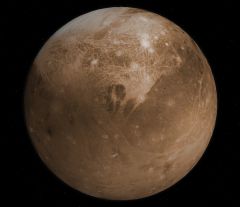Difference between revisions of "13434 Pluto"
(Corrected link.) |
(Added number of satellites.) |
||
| Line 12: | Line 12: | ||
|width="30%"|Reference body||align="right" width="30%"|Sun | |width="30%"|Reference body||align="right" width="30%"|Sun | ||
|- | |- | ||
| − | |width="30%"|Number of satellites||align="right" width="30%"| | + | |width="30%"|Number of satellites||align="right" width="30%"|5 |
|- | |- | ||
!bgcolor="lightsteelblue" colspan="2"|Planetary mean orbits | !bgcolor="lightsteelblue" colspan="2"|Planetary mean orbits | ||
Revision as of 03:04, 10 September 2024
Pluto (134340 Pluto) is a dwarf planet in the Kuiper Belt of the Solar System. It was disovered by Clyde Tombaugh in February 1930. The dwarf planet is the ninth largest body that moves around the Sun. At first, Pluto was called a planet and is the largest body in the Kuiper belt.
Like other members of the Kuiper belt, Pluto is mainly made of rock and ice. It is quite small. It is about a fifth (⅕) of the weight of the Earth's Moon. It is only a third (⅓) its volume. Pluto is very far from the Sun, so its temperature is very low. The average temperature on Pluto is -223 degrees Celsius. It has an odd orbit and this orbit is very sloped. It takes Pluto to 30 to 49 AU (4.4–7.4 billion km) from the Sun. This causes Pluto to sometimes go closer to the Sun than Neptune.
At the time of its discovery, Pluto was considered a planet and was thought to be single body, but, in 1998 it was found to have a moon about half the radius of Pluto. In 2006, as part of the International Astronomical Union (IAU) redefinition of planet and dwarf planet, henceforth, Pluto was reclassed as a dwarf planet.
Pluto's orbit is in a 3:2 resonance with that of Neptune.
Pluto in Orbiter
Pluto was first introduced with the release of pluto_pack.zip in July 2004.
| Add-on | Source | Version | Author | Type | Release Date | Compatibility | Wiki article |
|---|---|---|---|---|---|---|---|
| Pluto Pack | AVSIM | CharlotMan | Scenery | 17 July 2004 | |||
Gallery
Image of Pluto by New Horizons spacecraft in July, 2015
References
| edit Natural satellites of Pluto |
|---|
| edit The Solar System | |
|---|---|
| Central star |
Sun (Sol) |
| Planets |
Mercury - Venus - Earth - Mars - Jupiter - Saturn - Uranus - Neptune |
| Natural satellites |
Moon - Phobos - Deimos - Io - Europa - Ganymede - Titan - more... |
| Add-ons |
Planets - Dwarf Planets - Small objects - Natural satellites - Alternative star systems |



